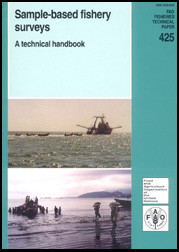
FAO Fisheries Technical Paper 425
Sample-based fishery surveys
By
Constantine Stamatopoulos
Preface
Among the major tasks of FAO is the promotion of improved approaches and techniques for the collection of data on agricultural statistics, including fisheries and forestry. The need for reliable and comprehensive statistics has always been extremely important, the more so at present as they from the essential basis for planning sustainable harvesting and environmental protection within the precautionary approach. Statistical programmes, however, require a significant effort and funds for their development and implementation and these are major constraints for many countries with limited human and financial resources. The merits of sampling approaches lie in providing cost-effective and efficient methods for the collection of data, further contributing to the development of the statistics urgently needs by fishery managers and planners.
Collection of basic data on catches, fishing effort and prices provides the primary data for a wide variety of statistical applications. In addition, more detailed data (fishing vessels, gear and operations; socio-economic data; etc) from sample-based fishery surveys conducted on a regular basis are an important source of fishery information of wide utility and scope.
To help meet national needs for basic fishery data FAO has been assisting countries in upgrading their data collection, processing and reporting capabilities. Technical assistance at national and regional level is a significant component of the work programme of FAO’s technical units responsible for fishery statistical development and involves both normative and field programme activities. Outputs of normative activities include technical documents on statistical methodology and guidelines for data collection. Field programme activities involve project formulation and implementation, technical backstopping and organization of training courses and workshops.
The purpose of this publication is to summarize, in handbook from, experience gained over recent years in fishery statistical development by the fishery information, Data and Statistics Unit (FIDI) of FAO, and provide planners and users of fishery surveys with simple and step-by-step guidance for developing and implementing cost-effective and sustainable fishery surveys. The methodological and operational concepts discussed here apply equally to both marine and inland capture fisheries and are presented in a manner that is generic enough to make them adaptable to most commonly used data collection systems. Statistical aspects are presented in a descriptive rather than theoretical manner. Emphasis is placed on the understanding and interpretation of the statistics and related indicators collected, rather than on the computations producing them. Readers interested in a more in-depth discussion on statistical and computing approaches may make use of the list of references that is given at the end of the handbook.
Contents
1 – Introduction
2 – Concepts in Estimating Catch
3 - Concepts in Estimating Effort
4 – General Sampling Considerations
5 – Survey Standards
6 – Surveys for Basic Fishery Data
7 – Active Days Surveys
8 – Frame Surveys
9 – Boat Activity Surveys
10 – Landing Surveys
11 – Data Processing
12 – Data Storage and Dissemination
13 – Further Reading



ساحة النقاش